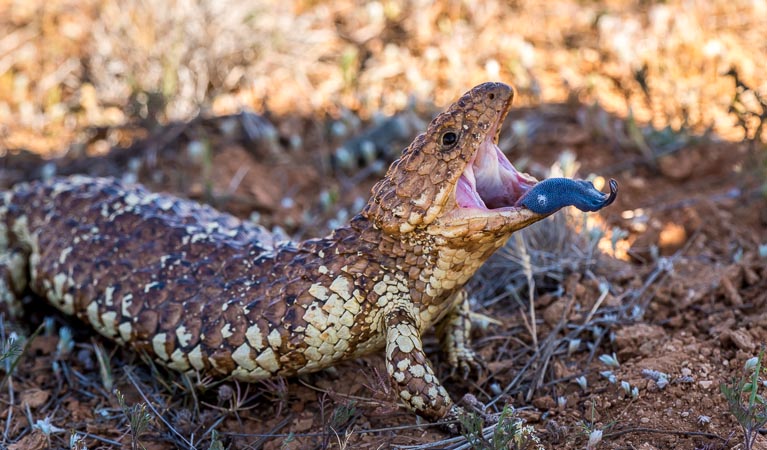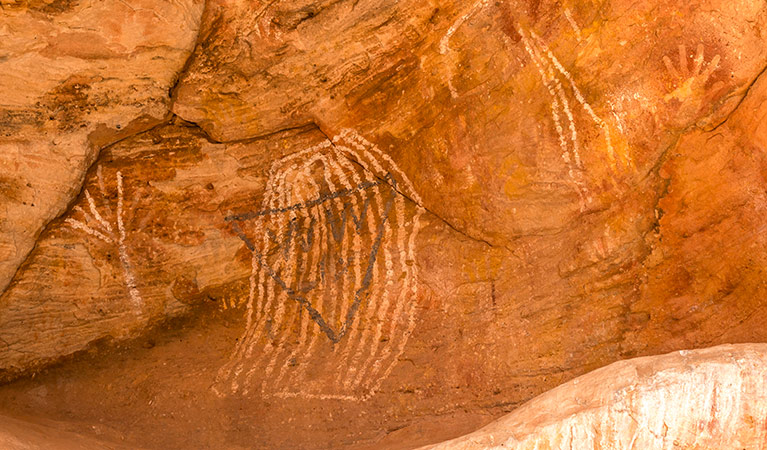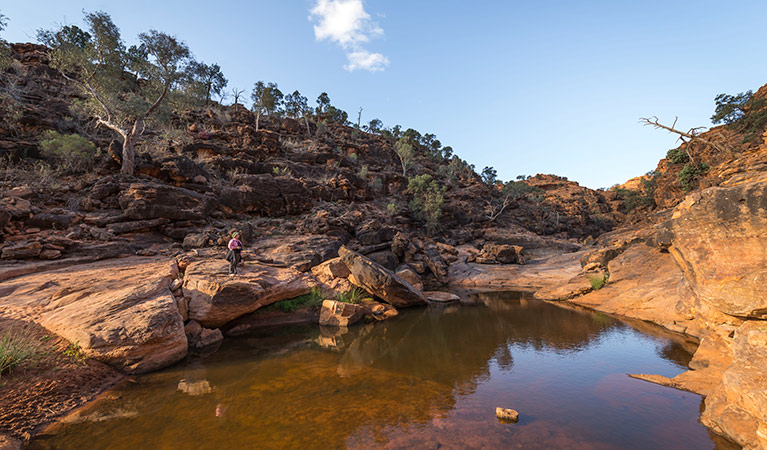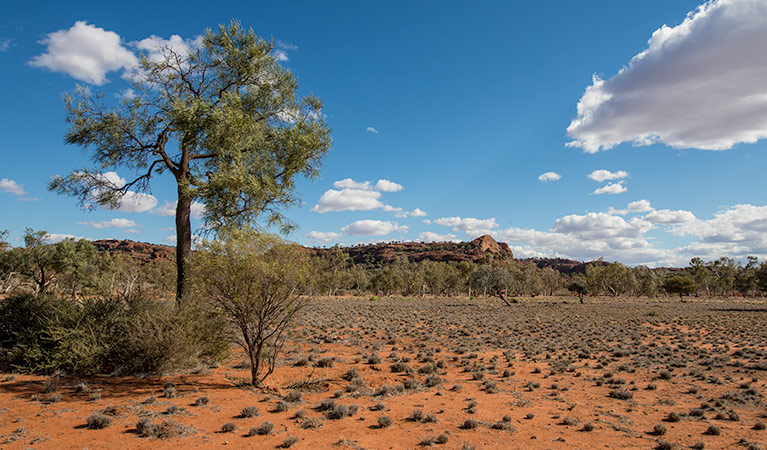Overview
The Old Coach Road drive is a piece of Australian history, following a section of the historic Broken Hill to White Cliffs Coach Run that connected these two outback towns.
- Where
- Mutawintji National Park in Outback NSW
- Accessibility
- Easy
- Distance
- 10km one-way
- Please note
- Many of the park’s roads are unsealed so take extra care, bring plenty of petrol, food and water and check the weather before setting out
- Remember to take your binoculars if you want to bird watch
The short drive takes in the ruins of the Rockholes Hotel that was built to accommodate passing trade between the two towns, as well as spectacular rock formations like Wana Karnu and Split Rock.
Also along the drive you'll find great spots for viewing the kangaroos, wallaroos and emus that live in the park.
After a 10km drive to the end of the road, you'll see that Split Rock is a 3km walk from the carpark, so come prepared for a bit of bushwalking and plenty of photo opportunities. You'll also find a picnic table so be sure to bring a tasty picnic lunch along.
If you're planning to do the Mutawintji Wilderness trek beyond Split Rock, you'll need to fill in a trip intention form to send important details about your trip to an emergency contact. For local safety tips contact the Broken Hill office.
Map

Map legend

Local alerts
For the latest updates on fires, closures and other alerts in this area, see https://www.nationalparks.nsw.gov.au/things-to-do/driving-routes/old-coach-road-drive/local-alerts
General enquiries
- National Parks Contact Centre
- 7am to 7pm daily
- 1300 072 757 (13000 PARKS) for the cost of a local call within Australia excluding mobiles
- parks.info@environment.nsw.gov.au
Park info
- in Mutawintji National Park in the Outback NSW region
Mutawintji National Park is always open but may have to close at times due to poor weather or fire danger.
Visitor info
All the practical information you need to know about Old Coach Road drive.
Getting there and parking
Upon entering Mutawintji National Park, you'll pass by the visitor centre, take the left fork for the Old Coach Road - you might like to stop in at the visitor centre for a map.
Parking
Parking is available at the end of the Old Coach Road drive
Best times to visit
Mutawintji National Park is best visited during autumn, winter and spring when daytime weather is pleasant. Summer in the outback can be very hot.
Weather, temperature and rainfall
Summer temperature
Average
30°C and 35°C
Highest recorded
48.6°C
Winter temperature
Average
17°C and 31°C
Lowest recorded
-3.3°C
Rainfall
Wettest month
January
Driest month
September
The area’s highest recorded rainfall in one day
140.2mm
Maps and downloads
Accessibility
Disability access level - easy
This area is fully wheelchair accessible
Prohibited
Pets
Pets and domestic animals (other than certified assistance animals) are not permitted. Find out which regional parks allow dog walking and see the pets in parks policy for more information.
If you're travelling through a national park or reserve on a public road you can have pets inside your vehicle. However, you must keep them inside your vehicle while driving through national parks or reserves. You must also comply with any conditions in the park’s plan of management, and you cannot stop to visit the park or use park facilities (unless for safety reasons, or to use publicly accessible toilets).
Smoking
NSW national parks are no smoking areas.
Visitor centre
-
Mutawintji Visitor Centre
51 Old Coach Road, Mutawintji, NSW 2880 - Mutawintji Visitor Centre is always open but it's unstaffed (self service).
Learn more
Old Coach Road drive is in Mutawintji National Park. Here are just some of the reasons why this park is special:
A wildlife wonderland

It might feel peaceful here, but Mutawintji teems with the wildlife that has occupied these lands since ancient times. You might see a wedge-tailed eagle or even a peregrine falcon and enjoy the chatter of noisy short-billed correllas, zebra finches, budgerigars, apostle birds and magpies. Crossing your path may be goannas and snakes, and look out for members of the only colony in NSW of the endangered yellow-footed rock wallaby. The largest of the rock-wallabies, it is Australia's most brightly coloured mammal - look for them on rocky ridges in the park.
- Homestead Gorge walking track Take a breathtaking walk along Homestead Gorge walking track for scenic landscape vistas and ancient Aboriginal rock engravings. Plus you might see wallabies, emus and birds.
- Old Coach Road drive The Old Coach Road drive is a piece of Australian history, following a section of the historic Broken Hill to White Cliffs Coach Run that connected these two outback towns.
An important Aboriginal site

The traditional home of the Pantjikali, Wanyuparlku, Wilyakali and Malyangapa people, Mutawintji National Park has been a significant meeting place for local cultures for thousands of years. Communities have performed initiations, rainmaking and other ceremonies here in gatherings of up to 1000 people. A short, easy walk, suitable for wheelchairs, will guide you amid the splendour of Mutawintji's gorges to the rocky overhang Thaaklatjika (Wright's Cave). Here you'll find paintings, stencils and engravings that depict pre and post colonial Aboriginal history, as well as the animals that live in the area, including kangaroos and emus.
- Homestead Gorge walking track Take a breathtaking walk along Homestead Gorge walking track for scenic landscape vistas and ancient Aboriginal rock engravings. Plus you might see wallabies, emus and birds.
- Mutawintji cultural tour Join this special tour in Mutawintji National Park in the NSW outback and hear Aboriginal guides share their connection to their Country.
- Rockholes Loop walking track Rockholes Loop walking track is an adventurous extension to Homestead Gorge walking track, in Mutawintji National Park. This short but steep hike includes Aboriginal engravings and splendid views of rockholes, Homestead Gorge and Bynguano Range.
- Wiimpatja campfire yarn in Mutawintji Gather around the campfire under the desert sky in Mutawintji National Park. Listen to your Aboriginal guide's stories while tasting bush tucker.
Iconic scenery

Mutawintji National Park displays the classic outback landscape for which Australia is famous around the world. Driving along red dirt roads among rugged gorges and desert, against the backdrop of the ever-changing colour of the Byngnano Ranges, you'll discover the peace and space of the desert. Beyond the ridges, the saltbush and mulga plains stretch to the horizon, making city life seem a long, long way away.
- Homestead Gorge walking track Take a breathtaking walk along Homestead Gorge walking track for scenic landscape vistas and ancient Aboriginal rock engravings. Plus you might see wallabies, emus and birds.
- Mutawintji cultural tour Join this special tour in Mutawintji National Park in the NSW outback and hear Aboriginal guides share their connection to their Country.
- Mutawintji Gorge walking track Mutawintji Gorge walking track takes you on a hike through one of the park’s most scenic gorges. Enjoy a picnic at the end or simply spend some time taking in the view.
- Rockholes Loop walking track Rockholes Loop walking track is an adventurous extension to Homestead Gorge walking track, in Mutawintji National Park. This short but steep hike includes Aboriginal engravings and splendid views of rockholes, Homestead Gorge and Bynguano Range.
- Split Rock walking track Explore the rugged outback landscape of Mutawintji National Park along Split Rock walking track. This wild walk near Broken Hill is significant to Aboriginal women's cultural practices.
Plants and animals protected in this park
Animals
-

Wedge-tailed eagle (Aquila audax)
With a wingspan of up to 2.5m, the wedge-tailed eagle is Australia’s largest bird of prey. These Australian animals are found in woodlands across NSW, and have the ability to soar to heights of over 2km. If you’re bird watching, look out for the distinctive diamond-shaped tail of the eagle.
-

Red kangaroo (Macropus rufus)
The red kangaroo is one of the most iconic Australian animals and the largest marsupial in the world. Large males have reddish fur and can reach a height of 2m, while females are considerably smaller and have blue-grey fur. Red kangaroos are herbivores and mainly eat grass.
-

Emu (Dromaius novaehollandiae)
The largest of Australian birds, the emu stands up to 2m high and is the second largest bird in the world, after the ostrich. Emus live in pairs or family groups. The male emu incubates and rears the young, which will stay with the adult emus for up to 2 years.
Plants
-

Sturt's desert pea (Swainsona formosa)
One of Australia’s most famous desert wildflowers, Sturt’s desert pea is found across inland arid regions of Australia, including far west NSW. One of the most easily-recognised Australian native plants, Sturt’s desert pea thrives in red sandy soil, or loam, and has vibrant red leaf-shaped flowers with a black centre, known as a ‘boss’.
-

Saltbush (Atriplex nummularia)
A hardy Australian native plant, the saltbush is a small spreading shrub that can withstand dry salty soils such as those found in the desert plains of western NSW. It is grey-white in colour and has small spear-shaped succulent leaves. It flowers from December to April.

